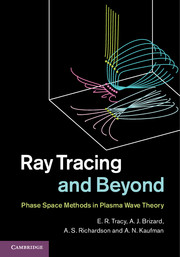Book contents
- Frontmatter
- Dedication
- Contents
- Preface
- Acknowledgements
- 1 Introduction
- 2 Some preliminaries
- 3 Eikonal approximation
- 4 Visualization and wave-field construction
- 5 Phase space theory of caustics
- 6 Mode conversion and tunneling
- 7 Gyroresonant wave conversion
- Appendix A Cold-plasma models for the plasma dielectric tensor
- Appendix B Review of variational principles
- Appendix C Potpourri of other useful mathematical ideas
- Appendix D Heisenberg–Weyl group and the theory of operator symbols
- Appendix E Canonical transformations and metaplectic transforms
- Appendix F Normal forms
- Appendix G General solutions for multidimensional conversion
- Glossary of mathematical symbols
- Author index
- Subject index
Preface
Published online by Cambridge University Press: 05 April 2014
- Frontmatter
- Dedication
- Contents
- Preface
- Acknowledgements
- 1 Introduction
- 2 Some preliminaries
- 3 Eikonal approximation
- 4 Visualization and wave-field construction
- 5 Phase space theory of caustics
- 6 Mode conversion and tunneling
- 7 Gyroresonant wave conversion
- Appendix A Cold-plasma models for the plasma dielectric tensor
- Appendix B Review of variational principles
- Appendix C Potpourri of other useful mathematical ideas
- Appendix D Heisenberg–Weyl group and the theory of operator symbols
- Appendix E Canonical transformations and metaplectic transforms
- Appendix F Normal forms
- Appendix G General solutions for multidimensional conversion
- Glossary of mathematical symbols
- Author index
- Subject index
Summary
Waves exist in a great variety of media (in all phases of matter) as well as a vacuum (in the case of electromagnetic waves). All simple waves, on the one hand, share some basic properties such as amplitude, frequency and period, wavelength, and wave velocity (both phase and group velocity). Waves in a turbulent medium, or waves generated by random sources, on the other hand, are more appropriately described in terms of probability distributions of amplitude, and spectral densities in frequency and wavelength. In this book, we focus primarily upon coherent waves that are locally plane wave in character. That is, they have a well-defined amplitude, phase, and polarization at most (but not all) points. The regions where this local plane-wave approximation breaks down are important, and the development of appropriate local methods to deal with them is an important topic of the book. We include a very short discussion of phase space approaches for incoherent waves, for completeness.
This is the first book to present modern ray-tracing theory and its application in plasma physics. The emphasis is on methods and concepts that are generally applicable, including methods for visualizing ray families in higher dimensions. A self-contained exposition is given of the mathematical foundations of ray-tracing theory for vector wave equations, based upon the Weyl theory of operator symbols. Variational principles are used throughout. These provide a means to derive a Lorentz-covariant ray theory, along with related conservation laws for energy, momentum, and wave action.
- Type
- Chapter
- Information
- Ray Tracing and BeyondPhase Space Methods in Plasma Wave Theory, pp. xiii - xviiiPublisher: Cambridge University PressPrint publication year: 2014



